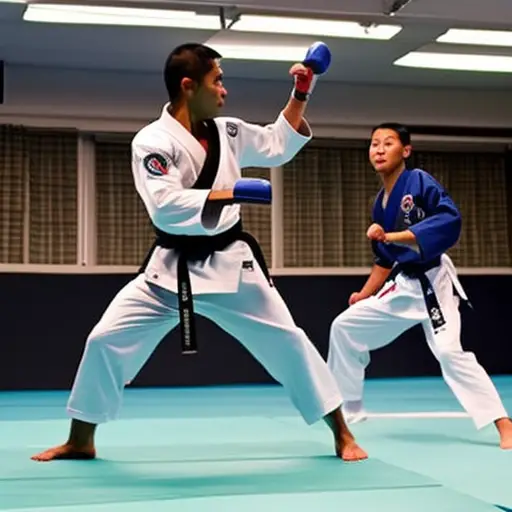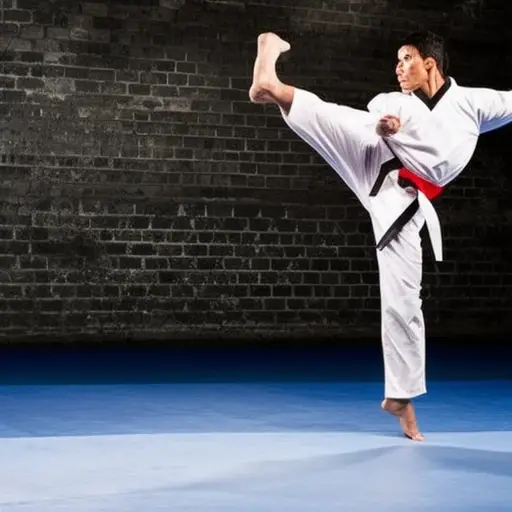How to Teach Taekwondo: Tips for Instructors

As a taekwondo instructor, it is crucial to possess the knowledge and skills necessary to effectively teach this martial art.
This article aims to provide valuable tips and insights for instructors on how to enhance their teaching approach.
By setting clear objectives, establishing effective communication, and creating engaging lesson plans, instructors can create a positive learning environment where students can thrive.
With a focus on individualized instruction, continuous learning, discipline, and respect, instructors can inspire and empower their students on their taekwondo journey.
Setting Clear Objectives
One of the key factors in teaching Taekwondo effectively is to establish clear and measurable objectives for your students. By setting clear objectives, instructors provide students with a sense of direction and purpose in their training. Clear objectives help students understand what they are working towards and motivate them to stay focused and committed.
Clear objectives in Taekwondo should be specific and measurable. For example, instead of setting a vague objective like ‘improve kicks,’ a clearer objective would be ‘increase kicking height by 10 inches.’ This specificity allows both the instructor and the student to track progress and evaluate whether the objective has been achieved.
Measurable outcomes are crucial in Taekwondo because they provide tangible evidence of improvement. It allows instructors to assess the effectiveness of their teaching methods and adjust their approach if necessary. Additionally, measurable outcomes give students a sense of accomplishment and satisfaction when they achieve their objectives.
When setting clear objectives, it is important to consider the individual abilities and goals of each student. Objectives should be challenging but attainable, taking into account the student’s skill level and physical capabilities. By tailoring objectives to each student, instructors can ensure that they are providing appropriate guidance and support.
Establishing Effective Communication
Effective communication plays a crucial role in establishing a productive learning environment for Taekwondo students. As an instructor, it is essential to develop effective listening skills to ensure clear and accurate understanding of students’ needs and concerns. By actively listening to their questions and feedback, instructors can address any issues that arise promptly and effectively.
In addition to listening, instructors must also be aware of nonverbal cues. Body language, facial expressions, and gestures can provide valuable insights into students’ emotions and level of engagement. Being attuned to these cues allows instructors to adjust their teaching style accordingly and ensure that students feel supported and understood.
To establish effective communication, instructors should strive to create an open and welcoming atmosphere where students feel comfortable expressing themselves. Encouraging dialogue and providing opportunities for students to ask questions and share their thoughts fosters a sense of collaboration and mutual respect.
Creating Engaging Lesson Plans
To ensure an immersive and dynamic learning experience, instructors can incorporate various teaching techniques and instructional strategies into their lesson plans. By creating well-structured and engaging lesson plans, instructors can effectively deliver content to their students and keep them motivated throughout their Taekwondo training.
One effective strategy for creating engaging lesson plans is to incorporate a variety of teaching strategies. This helps cater to different learning styles and keeps the class interesting. In the table below, we have outlined five teaching strategies and how they can be applied in Taekwondo instruction:
| Teaching Strategy | Description |
|---|---|
| Cooperative Learning | Students work together in small groups to achieve a common goal. This encourages teamwork and improves communication skills. |
| Visual Aids | Using visual aids such as diagrams, videos, or posters helps students visualize techniques and concepts. This enhances understanding and retention. |
| Problem-Based Learning | Students are presented with real-world problems and are encouraged to find solutions using their Taekwondo knowledge. This promotes critical thinking and problem-solving skills. |
| Active Learning | Instructors incorporate physical activities and games into the lesson to keep students actively engaged. This helps improve physical fitness and enhances skill development. |
| Technology Integration | Utilizing technology tools such as video analysis software or online resources can enhance the learning experience and provide additional resources for students to explore. |
Providing Individualized Instruction
When teaching Taekwondo, providing individualized instruction is crucial for the progress and development of each student.
Personalized training techniques allow instructors to tailor their approach to the specific needs and abilities of each student, ensuring that they receive the most effective and efficient instruction possible.
Personalized Training Techniques
Tailoring instruction based on students’ unique needs is crucial for instructors to provide a personalized training experience in Taekwondo. To achieve this, instructors must utilize personalized feedback and adaptive training techniques.
Here are four effective ways instructors can provide individualized instruction:
-
Assessing strengths and weaknesses: By assessing each student’s strengths and weaknesses, instructors can understand their specific areas of improvement and tailor their training accordingly.
-
Setting personalized goals: Instructors should work with each student to set personalized goals that align with their abilities and aspirations, providing them with a sense of purpose and motivation.
-
Modifying techniques: Instructors should adapt techniques to suit each student’s physical capabilities, ensuring they can perform effectively while minimizing the risk of injury.
-
Providing continuous feedback: Regular and personalized feedback is essential for students to understand their progress and make necessary adjustments to their training methods.
Adapting to Different Abilities
One important aspect of teaching Taekwondo is being able to accommodate varying abilities by providing individualized instruction.
In order to effectively adapt to different abilities, instructors should utilize differentiation strategies and inclusive teaching methods.
Differentiation strategies involve tailoring instruction to meet the specific needs of each student. This can include modifying techniques or exercises to accommodate different physical abilities or providing additional support or challenges based on individual skill levels.
Inclusive teaching methods aim to create an inclusive and supportive environment where all students feel valued and included. This can involve using clear and concise instructions, providing visual aids or demonstrations, and offering opportunities for students to work together and learn from one another.
Promoting a Positive Learning Environment
Creating a supportive and encouraging atmosphere is essential for fostering a conducive learning environment in Taekwondo classes. As an instructor, it is important to promote a positive learning environment that builds student confidence and fosters teamwork and collaboration. Here are four tips to help you achieve this:
-
Set clear expectations: Clearly communicate your expectations for behavior, effort, and respect to your students. This will provide them with a framework for their learning and help them understand what is required of them.
-
Provide constructive feedback: Offer feedback that is specific, constructive, and encouraging. This will help students understand their strengths and areas for improvement, while also motivating them to continue working hard.
-
Encourage peer support: Promote a culture of teamwork and collaboration by encouraging students to support and help each other. This can be done through partner exercises, group activities, or peer mentoring programs. By working together, students will develop a sense of camaraderie and learn from one another.
-
Celebrate achievements: Recognize and celebrate the achievements of your students, no matter how big or small. This can be done through verbal praise, certificates, or even small rewards. By acknowledging their progress and effort, you will boost their confidence and motivation to continue learning and improving.
Incorporating Fun and Interactive Activities
In order to keep students engaged and motivated in their Taekwondo classes, instructors can incorporate fun and interactive activities. One effective method is to include games that promote physical fitness and skill development, such as relay races or obstacle courses.
Additionally, creative teaching methods, such as using props or incorporating music, can make the learning experience more enjoyable for students.
However, it is important for instructors to strike a balance between fun and discipline to ensure a productive and safe learning environment.
Games for Engagement
Utilize dynamic and engaging games to captivate and involve students during Taekwondo lessons. Incorporating interactive warm-ups and team-building exercises into your classes can not only make the learning experience more enjoyable but also enhance student engagement and retention. Here are four games that can help you achieve these goals:
-
Simon Says: Use Taekwondo techniques as commands in this classic game. Students must listen carefully and execute the movements correctly to stay in the game.
-
Obstacle Course: Set up a challenging course that requires students to perform various Taekwondo moves to navigate through it. This game promotes agility, coordination, and focus.
-
Tag with a Twist: Play a traditional game of tag, but instead of using hands, students must tag each other using specific Taekwondo kicks or strikes.
-
Team Relay Races: Divide students into teams and have them compete in relay races that involve performing different Taekwondo techniques. This game encourages teamwork, communication, and friendly competition.
By incorporating these games, you can create a fun and interactive environment that keeps students motivated and eager to learn.
Transitioning into the subsequent section about ‘creative teaching methods’, let’s explore additional strategies to enhance the Taekwondo learning experience.
Creative Teaching Methods
To engage students actively in their Taekwondo lessons, instructors can incorporate fun and interactive activities through the use of creative teaching methods. By implementing innovative techniques and interactive drills, instructors can create an environment that is both enjoyable and educational for their students.
One example of a creative teaching method is to divide the class into teams and have them compete in friendly sparring matches. This not only allows students to practice their techniques in a realistic setting, but also promotes teamwork and sportsmanship.
Another method is to incorporate games and challenges that require students to use their Taekwondo skills, such as obstacle courses or target practice. These activities not only make the lessons more engaging, but also help students develop their skills in a fun and interactive way.
By using these creative teaching methods, instructors can ensure that their students have a positive and rewarding experience in their Taekwondo classes.
In the subsequent section about ‘balancing fun and discipline’, instructors must find a way to maintain a balance between making the lessons enjoyable and maintaining discipline within the class.
Balancing Fun and Discipline
Maintaining a balance between fun and discipline in taekwondo classes involves incorporating interactive activities that engage students while still reinforcing the importance of discipline and focus. Finding a balance between discipline and enjoyment in taekwondo classes is crucial for creating a positive atmosphere while instilling discipline in taekwondo training.
Here are four ways to achieve this balance:
-
Incorporate games: Introduce games that require focus, teamwork, and discipline, such as relay races or obstacle courses. This allows students to have fun while still practicing important taekwondo skills.
-
Use rewards and incentives: Offer small rewards or incentives to students who demonstrate discipline and focus during training. This encourages them to stay motivated and disciplined while enjoying the process.
-
Include interactive drills: Incorporate drills that involve partner work or group activities. This not only keeps the class engaged but also helps students develop discipline through cooperation and communication.
-
Allow for creativity: Give students opportunities to express their creativity within the structure of the class. This can be done through choreographed patterns or freestyle sparring, where students can showcase their individuality while still following the principles of taekwondo.
Encouraging Continuous Learning and Improvement
As an instructor, it is important to create an environment that fosters continuous learning and improvement in your taekwondo students. Continuous improvement is a fundamental aspect of any martial art, including taekwondo. To encourage this mindset in your students, it is essential to implement effective learning strategies.
One effective learning strategy is to set clear goals and objectives for your students. By providing them with specific targets to work towards, you can motivate them to continuously strive for improvement. Regularly assessing their progress and providing constructive feedback will also help them identify areas for improvement and set new goals.
Another learning strategy is to incorporate various teaching methods and techniques. People have different learning styles, so it is important to cater to individual needs. Some students may learn best through visual demonstrations, while others may prefer hands-on practice. By diversifying your teaching methods, you can engage and accommodate all types of learners, thereby enhancing their learning experience.
Furthermore, encouraging a growth mindset in your students can greatly contribute to their continuous learning and improvement. Teach them that failure is an opportunity for growth and that setbacks are a natural part of the learning process. By instilling in them the belief that they can always improve with effort and dedication, you will motivate them to continuously push their boundaries.
Fostering Discipline and Respect
Discipline and respect are essential qualities that instructors must cultivate in their taekwondo students. These qualities not only contribute to a safe and disciplined training environment but also promote personal growth and character development. To foster discipline and respect in their students, taekwondo instructors can employ the following strategies:
-
Lead by example: Instructors should consistently demonstrate discipline, respect, and self-control in their own behavior and interactions with students. This sets the standard for students to follow.
-
Teach proper etiquette and behavior: Instructors should emphasize the importance of bowing, addressing seniors with respect, and following the rules and traditions of taekwondo. Teaching and reinforcing proper etiquette helps instill a sense of respect for the art and its practitioners.
-
Set clear expectations and boundaries: Instructors should establish clear rules and guidelines for behavior in the training setting. Consistently enforcing these expectations helps students understand the importance of discipline and respect.
-
Provide regular feedback and reinforcement: Instructors should regularly acknowledge and praise students who demonstrate discipline and respect. Constructive feedback can also be given to correct any lapses in behavior and guide students towards improvement.
Frequently Asked Questions
What Are Some Common Mistakes to Avoid When Teaching Taekwondo?
Common mistakes to avoid when teaching taekwondo include inadequate preparation, lack of clear communication, neglecting individual needs, and failure to provide proper guidance. Effective handling of these issues ensures a successful and impactful teaching experience.
How Can Instructors Effectively Handle Challenging Students or Behavioral Issues in a Taekwondo Class?
Instructors can effectively handle challenging students or behavioral issues in a Taekwondo class through the implementation of effective discipline techniques and the use of positive reinforcement. These strategies promote a positive learning environment and encourage students to improve their behavior and skills.
What Are Some Strategies for Motivating Students to Stay Committed and Continue Practicing Taekwondo Outside of Class?
Motivating students to practice Taekwondo outside of class requires strategic approaches. Instructors can encourage goal-setting, provide personalized feedback, offer incentives, and create a supportive community that fosters a sense of dedication and passion for the martial art.
Are There Any Specific Training Techniques or Drills That Can Help Students Improve Their Sparring Skills in Taekwondo?
To enhance sparring skills in Taekwondo, instructors can incorporate various sparring drills and techniques. These exercises focus on agility, speed, accuracy, and strategy, providing students with practical experience and improving their overall performance in sparring competitions.
How Can Instructors Assess and Track the Progress of Their Students in Taekwondo?
Assessing and tracking the progress of students in taekwondo is crucial for instructors. By employing various methods such as regular evaluations, performance assessments, and goal setting, instructors can effectively monitor and measure their students’ growth and development in the martial art.
Conclusion
In conclusion, teaching taekwondo requires instructors to:
- Set clear objectives
- Establish effective communication
- Create engaging lesson plans
- Provide individualized instruction
- Promote a positive learning environment
- Incorporate fun and interactive activities
- Encourage continuous learning and improvement
- Foster discipline and respect
One interesting statistic to evoke an emotional response is that taekwondo training has been shown to improve self-esteem and confidence in children. A study reported a 30% increase in self-confidence among participants.





